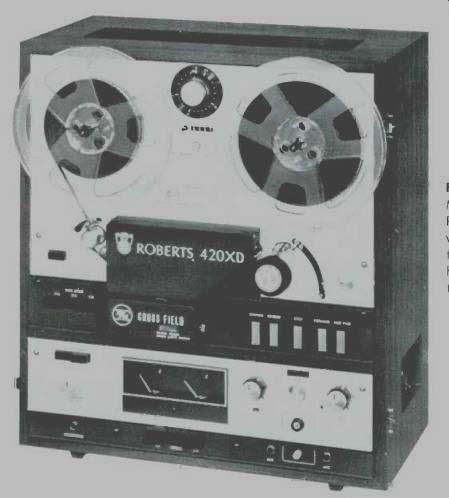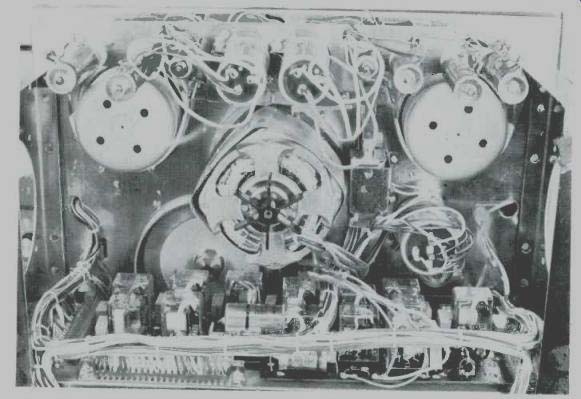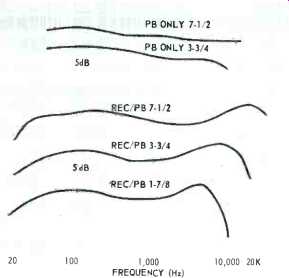MANUFACTURER'S SPECIFICATIONS:
Frequency Response: 30 to 22,000 Hz ±3 dB at 7 1/2 ips.
Tape Speeds: 1 7/8, 3 3/4, 7 1/2, and 15 ips. S/N: 50 dB.
Wow and Flutter: 0.12% at 7 1/2; 0.17% at 3 3/4; 0.20% at 1 7/8. Outputs: two preamp "line" outputs and 8ohm stereo headphone jack.
Heads: Erase, Record, Playback, and Crossfield head for bias; 2 micron (.000080") head gap on record and x 10 1/2" d.
Weight: 55 lbs.
Price: $699.95.

Fig. 1--Roberts Model 420XD Tape Recorder--a deck with auto reverse, four
speeds, and a host of other features in one machine.
The Roberts 420SD is actually a deck, in that it does not have a built-in power amplifier and speakers, nor does it have any provision for speakers.
You must connect it to another amplifier if you wish to hear the results on other than headphones. For those who require a built-in amplifier and speakers, there is another model420X-which does incorporate these features, and which costs an additional $100.00. Otherwise, the two models are identical except for weight--the 420X weighs 61 1/2 lbs.
The unit comes in an attractive wood housing, complete with a removable cover. It is designed for vertical operation, and accommodates 7in. reels. The hubs are fitted with spring-loaded retainers on both shafts.
A cutout on the right side of the case gives access to the input and line output phono jacks, as well as to a "DIN" type 4terminal socket which is used with many amplifiers to provide input and output connections with a single plug.
The mechanism is relay operated, with light-touch push buttons controlling all transport functions. Tape speed is selected by push buttons, as is the mode of operation-tracks 1 and 4, stereo, or tracks 2 and 3. Headphone and microphone jacks are located along the lower edge of the front panel, with a headphone level control just above the headphone jack at the lower left corner. Above this is the TAPE/SOURCE pushbutton assembly for monitor, and to the right are the record-level controls. These are dual-concentric, one pair for each channel. The front metal knob controls microphone level, while the black plastic knob at the rear controls the AUX input level. Between these two controls is the record push button, and above it, the record indicator light. Below it a unique feature: the Comput-O-matic Record Level Indicator. This device provides an unusual type of automatic level control. With the enabling button depressed during the recording of a number, the circuit mechanically rotates a volume control so that the loudest note recorded will be reduced to the proper recording level, and all other material thereafter will be recorded in equal proportion to the level set automatically for the loudest note or passage. This is auxiliary to the manual recording level controls, and functions only when the Comput-O-Matic SET button is depressed. If the button is not depressed, the job of controlling the recording level is done manually by the operator. A small indicator shows the position of the automatic control in what appears to be a knob--at maximum, it is in the position usually occupied by a manual knob in the maximum position--that is, at about 5 o'clock.
This feature is particularly helpful to the inexperienced user, since he is more likely to produce useable recordings than he could with only manual control.

Fig. 2--This shelf in the Roberts recorder carries the many relays which
control the functioning of the machine at the command of a series of push
buttons.
The 420XD is a reversible machine, and this entails the need for more than the usual four push buttons for operation-or five, if you include the RECORD button. The row of push buttons which control the tape motion incorporates five buttons REWIND, REVERSE, STOP, FORWARD, and FAST FWD. All of these control relays thirteen of them, as near as we could count-and solenoids, of which there are three. This is understandable, considering the number of functions which are controlled, and the combinations of these functions, which would be difficult for full manual control without the combinations.
The reversing process involves changing the direction of motor operation, reversing the duties of the spooling motors, and shifting the play head (the reverse function operates only on playback, not on recording). During recording, the Cross-Field head is raised up to a position about 0.05 in. from the record head, and the bias is applied from the back of the tape.
This system seems to improve the high-frequency response of the recorded signal, particularly at the slower speeds. When the recorder is at rest or in the playback mode, the crossfield head is away from the record head, as seen in the illustrations, so that tape threading can be accomplished readily without the interference of the additional head.
Another useful circuit in the unit is one called the "Head Sentry." It taps off the signal from the input transistor in the playback amplifier and feeds it through a string of transistor stages which are tuned to a high frequency.
If the heads-play or record-be come coated with residue from the tape or if they are only dirty, the high-frequency content of the signal is appreciably reduced, and the circuit causes the sentry lamp to light, thus indicating that the heads should be cleaned before continuing.

Fig. 3--Playback response from standard tapes at 7 1/2 and 3 3/4 ips, and
record/play responses for these speeds and for 17/R ips in addition.
Still another feature this one purely mechanical--is the selection of the point where the reversal of tape motion takes place. If only a part of a reel is recorded-as would be the case if the selection were not long enough to fill one side of the reel-the Reverse-O-Matic control can be set to reverse at that point, rather than waiting until the entire side had been played. A knob at the top of the panel operates over a scale calibrated in 100-foot increments, and this knob is set to the footage at which the reverse is to take place. When that amount of footage has passed through the machine, the unit reverses itself automatically. It is also possible to inaugurate the reverse action by affixing a strip of conductive foil to the tape at the point where it is to reverse. The control by the mechanism is put into action by depressing the Reverse-O-Matic SET button. As the tape is returned to the left reel, the scale will show the numbers reducing to zero, and at this point the machine will reverse again, playing in the forward direction. Thus continuous playing can be employed if desired.
Two other unusual features are the selection of brake tension for three different thicknesses of tape-standard or 1 1/2mil, 1.0mil, and 0.5mil --and the changeover from 60 to 50 Hz line supply. This latter control simply moves the main belt from one pair of pulleys to another. This makes it possible for the machine to be used in the U.S.A., where 60 Hz is the standard line frequency almost everywhere, or in the rest of the world where 50 Hz is the standard.
The tape is threaded over the damping lever and around an impedance roller at the left of the head assembly, then past the tape cleaner (which may be moved upward slightly for use with virgin tapes which do not need cleaning) past the heads and then under the capstan (this is, over the pinch roller), under the automatic stop lever and onto the take-up reel.
The machine will not run unless the tape holds the automatic lever up and thus away from the cutoff switch. A knob adjacent to this lever holds it away from the main power cutoff Microswitch during normal operation, but if it is desired to have the entire machine shut off--amplifiers as well as motors--the knob is turned slightly to the left so as to allow the shutoff lever to drop down fully and contact the second switch, which shuts off all the power to the unit.
From this description it can be seen that the machine is full of a number of fine features which simplify operation, make is as flexible as possible, and provide practically any function the recordist may want.
Performance
The 420XD comes fairly close to its specifications. Frequency response in playback from standard tapes is shown in Fig. 3, along with the record/play responses for the three slower speeds. We did not make any tests at the 15-ips speed because it appeared that there was some oscillation in the circuit. Signal-to-noise measured 48 dB below the 3% distortion point, which was at 10 dB above the indicated zero on the VU meters-both of which, by the way have only a single white line to indicate the "zero," and no other scale marking. Wow and flutter measurements were well below the specifications with figures of 0.08 percent at 7 1/2 ips, 0.11 at 3 3/4, and 0.17 at PA. Distortion was under 1 per cent at "0" recording level, and reached 3 percent only at a + 10 level. The tape used was Scotch 111.
The input signal required to reach a "0" recording level was less than 0.3 mV in the microphone circuit, and only 32 mV in the Aux input, and the line output level for a "0" recorded signal was 1.2 volts, constant, and not controllable from any panel controls.
The machine is a delight to use, and with the automatic level control-the Comput-O-Matic one never need worry about overloading a recording.
You simply feed in the signal with the automatic control "on," start the recording and "let 'er roll." The first loud note will be reduced in level to the correct "0" and the recording will continue with that setting of the automatic level control until a louder note comes along and then the control brings that one to the "0" again, and so on. To restore the control to the maximum sensitivity position again, simply press the button to OFF, remove the input, and depress the button again to ON. The control then returns to the maximum position.
You can make sound-on-sound recording on the 420XD, adding a new source to one already recorded on track 1 and recording the two together on track 3. And you can do it again back to track 1, if you like, and so on as often as you wish.
You can also add an echo effect by recording on the second track that which you have already recorded on the first, then playing back in stereo.
This gives the advantage of being able to control the echo effect better than if both signals were recorded on the same track, but it does necessitate that it be done with mono signals, and the effect is available only when the two tracks are played back simultaneously-that is, in stereo. Not the least of its advantages is the ability to mix a high-level (line) source with another signal introduced at the microphone jacks. Not all machines will permit mixing, but the 420XD does, and this is one of its many advantages.
It is not an inexpensive machine, but it does incorporate practically everything a recordist needs for serious work.
(Audio magazine, Feb. 1970)
Also see:
Revox A77 Dolby B Stereo Tape Recorder (Equip. Profile, Nov. 1972)
= = = =